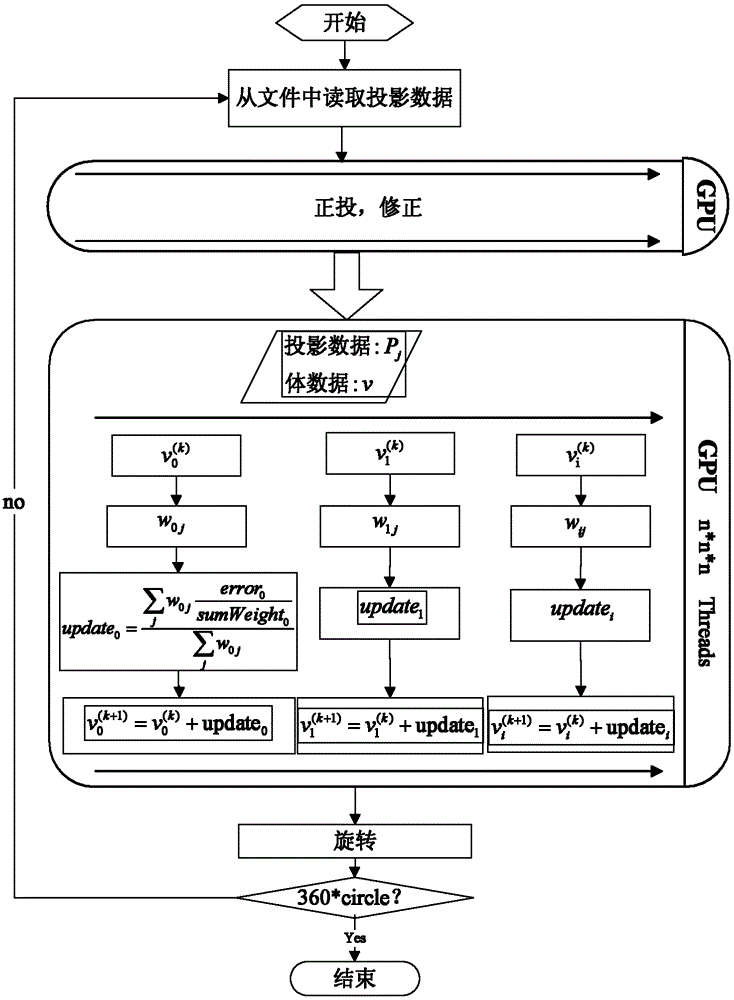GPU (graphics processing unit) acceleration CBCT image reconstruction method and device
An image reconstruction and algorithm technology, applied in image enhancement, image data processing, processor architecture/configuration, etc., which can solve the problems of slow reconstruction speed and inability to obtain satisfactory results from analytical image reconstruction algorithms.
- Summary
- Abstract
- Description
- Claims
- Application Information
AI Technical Summary
Problems solved by technology
Method used
Image
Examples
Embodiment 1
[0055] Example one, such as figure 1 As shown, including the following steps:
[0056] Step (1), read the projection data, and use the SART algorithm as the approximation item in the GPU to update the reconstructed volume;
[0057] Step (2), adopting an adaptive gradient descent method to minimize the total variation of the reconstructed volume;
[0058] Repeat steps (1) and (2), and iterate N times until the algorithm converges, where N is a natural number greater than one.
[0059] In this embodiment, by combining the SART algorithm and the TV minimization algorithm, the pseudo code of the proposed algorithm is as follows.
[0060] Algorithm pseudo code:
[0061] ng nd←4,λ←0.25,γ max ←0.95,γ red ←0.95
[0062] v → ← 0
[0063] Iteration_num←10 / / The number of main loop iterations
[0064] for(i=0;i
[0065] v → 0 ← v →
[0066] for(j=0;j
[0067] 1) Front projection: Calculate all simulated projection da...
Embodiment 2
[0091] Example two, such as figure 2 As shown, in the GPU acceleration of the SART loop part, in the orthographic projection process, the design is a light-driven method, that is, one thread calculates one light. In this way, for m*m projected pictures, the present invention can obtain m*m threads.
[0092] A GPU accelerated CBCT image reconstruction method includes the following steps:
[0093] Step (1), read the projection data, and use the SART algorithm as the approximation item in the GPU to update the reconstructed volume;
[0094] Step (2), adopting an adaptive gradient descent method to minimize the total variation of the reconstructed volume;
[0095] Repeat steps (1) and (2), and iterate N times until the algorithm converges, where N is a natural number greater than one.
[0096] Specifically, the step (1) further includes the following steps:
[0097] (10): When the projection data of each projection angle of the reconstructed volume is composed of m*m pixels, m*m parallel i...
Embodiment 3
[0124] The third embodiment, correspondingly, the embodiment of the present invention also provides a GPU accelerated CBCT image reconstruction device, such as Figure 4 As shown, it includes the following parts:
[0125] Image reconstruction module: used to read the projection data, use the SART algorithm as the approximation item in the GPU to update the reconstructed volume;
[0126] Denoising module: used to adopt an adaptive gradient descent method to minimize the total variation of the reconstructed volume;
[0127] Iteration module: used to iterate until the algorithm converges.
[0128] Such as Figure 5 As shown, specifically, the image reconstruction module further includes:
[0129] Orthographic projection unit: used to calculate the simulated projection data of the projection angle on the detector plane, and calculate the projection error according to the real projection data and the simulated projection data of each projection angle to obtain a corrected image;
[0130] Back...
PUM
 Login to View More
Login to View More Abstract
Description
Claims
Application Information
 Login to View More
Login to View More - R&D
- Intellectual Property
- Life Sciences
- Materials
- Tech Scout
- Unparalleled Data Quality
- Higher Quality Content
- 60% Fewer Hallucinations
Browse by: Latest US Patents, China's latest patents, Technical Efficacy Thesaurus, Application Domain, Technology Topic, Popular Technical Reports.
© 2025 PatSnap. All rights reserved.Legal|Privacy policy|Modern Slavery Act Transparency Statement|Sitemap|About US| Contact US: help@patsnap.com



